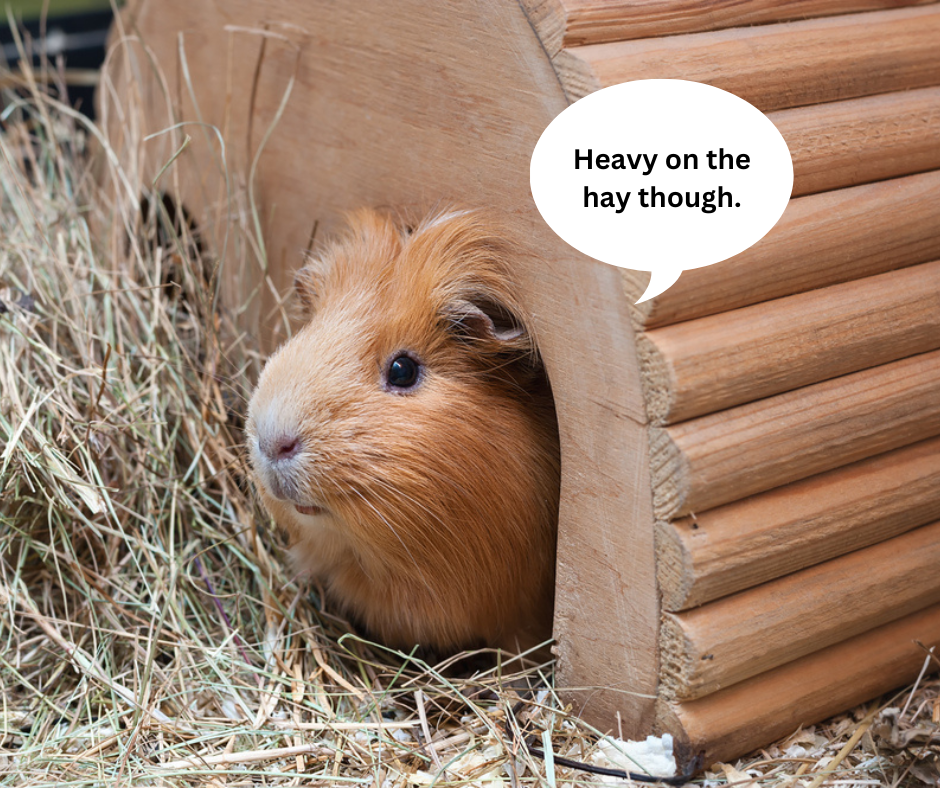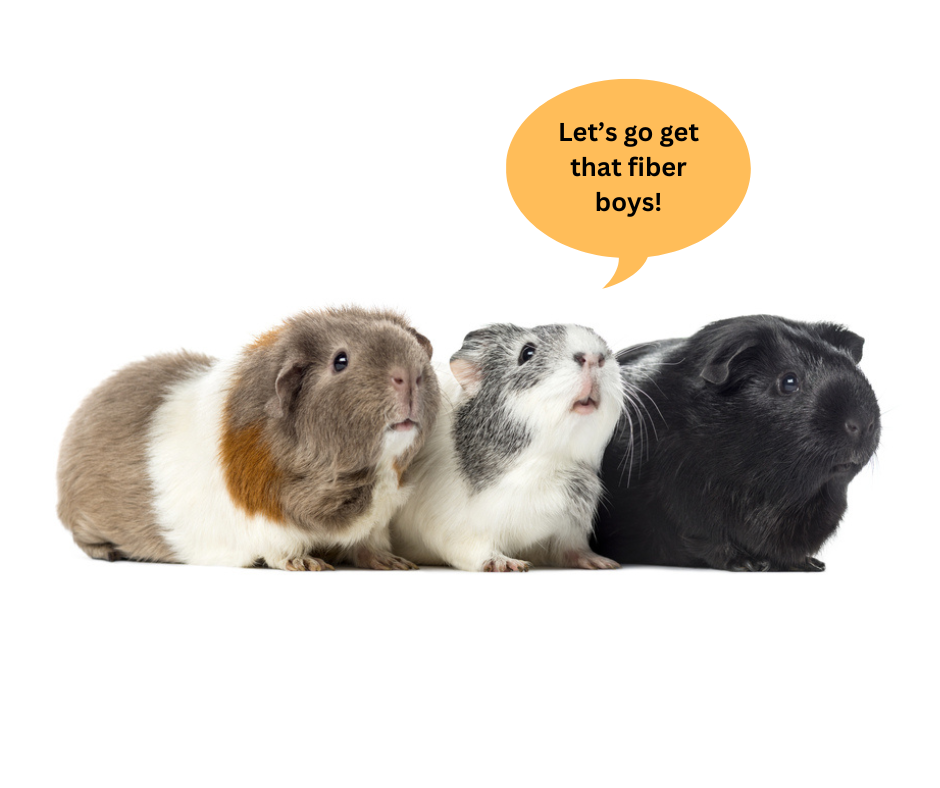Guinea pigs are a lot of fun. Today we’re talking all about the fuel for the fun, and that includes guinea pig pellet food. The food your cavy needs is simple really but digestive problems sure can get complicated fast. So today we are focused on prevention.
And what better way to do that than with food!
For those who would rather listen than read, Saskia is talking all about how to feed your guinea pig a balanced diet on YouTube!
What Guinea Pig Food Consists Of
When we say guinea pig food, we’re not just talking about pellets. Though pellets are certainly part of the meal plan. Guinea pigs need a combination of hay, pellets, and fresh food every day.

A guinea pig's main focus when it comes to food is fiber. Fiber is what keeps their digestive system happy and in return gives them lots of energy.
When the digestive system stops moving, so does the guinea pig. Fiber helps move everything along properly and fosters good bacteria in your cavy’s gut.
What Kind Of Hay Do Guinea Pigs Need?
The best source of fiber your guinea pig will get is hay. This is also due to the fact that a guinea pig’s teeth are always growing and they need to chew rough guinea pig food to keep them worn down and healthy.
This keeps them pain-free as well as the ability to continue eating lots of fiber!

Full-grown healthy adult cavies should be fed unlimited amounts of low-calcium hay. Timothy hay or orchard hay are great options for adult guinea pigs.
Make sure you have fresh hay available for your guinea pig at all times. Additionally, this needs to be a type of hay that your guinea pig wants to eat. There are actually 3 different cuts of Timothy hay that yield slightly different results. There’s certainly room to try out different types of hay in order to find something your guinea pig loves.
Young Guinea Pigs
For guinea pigs that are younger than one year old, alfalfa hay is a good choice. Cavies this young need more calcium than adults to support their growing bodies.
Pregnant, nursing, or unwell guinea pigs may also benefit from a higher fat and higher calcium hay like alfalfa hay. However, check with your exotic veterinarian as most adult guinea pigs will do best on a low-calcium hay to avoid issues with their bladder and kidneys.
What To Look For In Guinea Pig Pellet Food
Pellet food is a bit like the breakfast cereal of the guinea pig world. It’s processed and easy to eat and is also supplemented with helpful vitamins. However, it’s more processed and doesn’t wear your cavy’s teeth down as well as hay does.
For this reason, limit your adult guinea pig to ⅛ cup of pellets. The first ingredient of guinea pig pellet food should always be hay. Guinea pig pellets should have simple ingredients without any dyes or fillers. When looking at guinea pig pellet food you should feel bored. That’s right, you don’t want any colorful pieces or seeds in your guinea pig food.
Young Guinea Pigs
If your guinea pig is less than six months old then they need access to unlimited guinea pig pellet food. Pregnant and nursing guinea pigs can also have access to unlimited pellets as both of these groups of cavies have additional demands on their body during these times.
How Much Fresh Food Should My Cavy Have?
Guinea Pig Food 101 would not be complete without every cavies favorite, fresh vegetables! Not all vegetables are created equal as some have more starch and sugar and should only be given as a treat.
However leafy greens can be fed every day. ½-1 cup of leafy greens a day is a great amount. Rotate through different vegetables so that your cavy is getting a variety of greens and not too much of any one nutrient.
Some great leafy greens for guinea pigs are:
- red and green leaf lettuce
- romaine lettuce
- kale
- cilantro
- parsley
- spinach
- dandelion greens
- cabbage
- endive
- carrot tops
- mint
- basil
- collard greens
- turnip greens
These vegetables are low in sugar and are less likely to upset your guinea pig’s stomach than a higher-sugar vegetable like a carrot. However, anytime you add something new to your guinea pig’s diet it's very important that you introduce the food slowly. Start them off with a small piece and see how they do.
Other low-sugar vegetables for your cavy to try:
- broccoli
- Brussel sprouts
- celery
- red and green bell pepper
Fresh foods that can be given in small pieces as a treat a few times a week are:
- apples (without the seeds)
- carrots
- bananas
- mango
- papaya
- kiwi
- blueberries
Fresh guinea pig food provides vitamin C which is very important for guinea pigs! They can’t make their own vitamin C so they need to get it from their diet. Quality guinea pig pellet food will be fortified with vitamin C as well!
Saskia is talking more about fruits for guinea pigs! Check out her video on YouTube.
Quality Guinea Pig Food For a Quality Life
Us guinea pig parents want to give our pets the very best that we can. Simply because we love seeing our pets at their best!
Once you’ve got the hay, the guinea pig pellet food, and the fresh food figured out, everything falls into place easier as far as your pet’s energy and willingness to explore and be social. A healthy guinea pig has all of their physical needs met so they have more time and energy for play!
We are not veterinarians, and none of our information should be construed as veterinary advice.
Before adding any new product, please consult your exotic veterinarian. If your pet is acting unwell and you have concerns for their well being, please contact your vet immediately.





